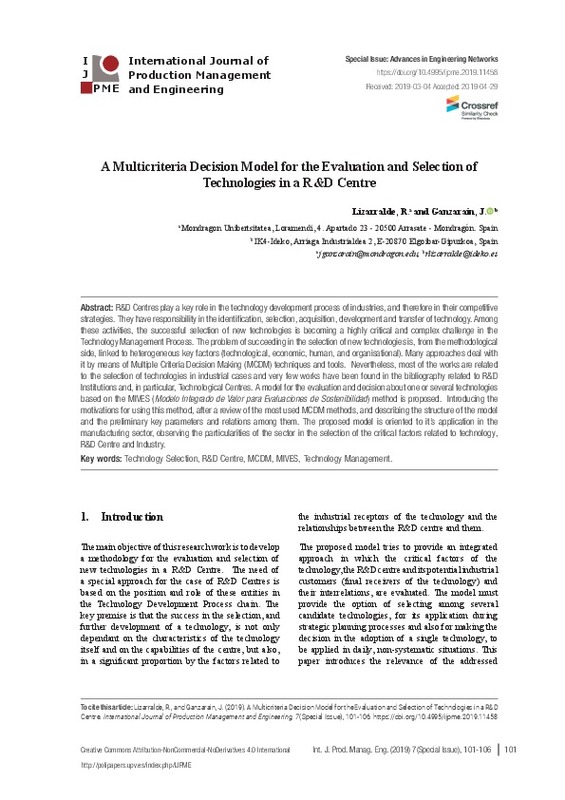Banuls, V.A., and Salmeron, J.L. (2006). A scenario-based assessment model - SBAM. Technological Forecasting and Social Change, 74(6), 750-762. https://doi.org/10.1016/j.techfore.2006.05.015
Brans, J.P., and Vincke, P. (1985). Note - A Preference Ranking Organisation Method. Management Science, 31(6), 647-656. https://doi.org/10.1287/mnsc.31.6.647
Charnes, A., Cooper, W.W., Lewin, A., Seiford, L.M. (1994). Data envelopment analysis: theory, methodology and applications. Massachusetts: Kluwer Academic Publishers. https://doi.org/10.1007/978-94-011-0637-5
[+]
Banuls, V.A., and Salmeron, J.L. (2006). A scenario-based assessment model - SBAM. Technological Forecasting and Social Change, 74(6), 750-762. https://doi.org/10.1016/j.techfore.2006.05.015
Brans, J.P., and Vincke, P. (1985). Note - A Preference Ranking Organisation Method. Management Science, 31(6), 647-656. https://doi.org/10.1287/mnsc.31.6.647
Charnes, A., Cooper, W.W., Lewin, A., Seiford, L.M. (1994). Data envelopment analysis: theory, methodology and applications. Massachusetts: Kluwer Academic Publishers. https://doi.org/10.1007/978-94-011-0637-5
Chen, S., Hwang, C., Beckmann, M., and Krelle, W. (1992). Fuzzy multiple attribute decision making: methods and applications. New York: Springer Verlag. https://doi.org/10.1007/978-3-642-46768-4_5
Clausen, T.H., Korneliussen, T., and Madsen, E.L. (2013). Modes of innovation, resources and their influence on product innovation: Empirical evidence from R&D active firms in Norway. Technovation, 33(6-7), 225-233. https://doi.org/10.1016/j.technovation.2013.02.002
Dalkey, N. C., and Helmer, O. (1963). An experimental application of the Delphi method to the use of experts. Management Science, 9(3), 458-467. https://doi.org/10.1287/mnsc.9.3.458
De la Concha, S. (2014). Horizonte2020, de la visión general a las oportunidades. XX y XXI Seminarios de Asesores de Proyectos de I+D de la Unión Europea.
Diffenbach, J. (1981). A compatibility approach to scenario evaluation. Technological Forecasting and Social Change, 19(2), 161-174. https://doi.org/10.1016/0040-1625(81)90013-5
Dobbs, R., Manyika, J., and Roxburh, C. (2012). Manufacturing the future: The next era of global growth and innovation. McKinsey Global, (November).
Felipe, J., Aashish, M., and Changyong, R. (2014). Manufacturing Matters... but it's the Jobs that Count. Asian Development Bank Working Paper No. 420.
Gregory, M.J. (1995). Technology management - a process approach. Proceedings of the Institution of Mechanical Engineers, 209(5), 347-356. https://doi.org/10.1243/PIME_PROC_1995_209_094_02
Grimaldi, M., Cricelli, L., Giovanni, M. Di, and Rogo, F. (2015). The patent portfolio value analysis: A new framework to leverage patent information for strategic technology planning. Technological Forecasting and Social Change, 94, 286-302 https://doi.org/10.1016/j.techfore.2014.10.013
Guan, J.C., Yam, R.C.M., Tang, E.P.Y., Lau, A.K.W. (2009). Innovation strategy and performance during economic transition: Evidences in Beijing, China. Research Policy, 38(5), 802-812. https://doi.org/10.1016/j.respol.2008.12.009
Hartmann, M.H. (1999). Theory and practice of technological corporate assessment. Journal of Engineering and Technology Management, 17(4), 504-521. https://doi.org/10.1504/IJTM.1999.002730
Kaldor, N. (1967). Strategic Factors in Economic Development. Ithaca: New York State School of Industrial and Labor Relations, Cornell University.
McGrath, R.G., MacMillan, I.C. (2000). Assessing technology projects using real options reasoning. Research-Technology Management, 43(4), 35-49. https://doi.org/10.1080/08956308.2000.11671367
Ordoobadi, S.M., Mulvaney, N.J. (2001). Development of a justification tool for advanced manufacturing technologies-value analysis. Journal of Engineering and Technology Management, 18(2),157-184. https://doi.org/10.1016/S0923-4748(01)00033-9
Phaal, R., Paterson, C.J., and Probert, D.R. (1998). Technology management in manufacturing business: process and practical assessment. Technovation, 18(8-9), 541-589. https://doi.org/10.1016/S0166-4972(98)00026-1
Phaal, R., Farrukh, C.J.P., and Probert, D.R. (2001). A framework for supporting the management of technological innovation. Engineering Department, University of Cambridge, 1-14.
Rohrbeck, R., Heuer, J., and Arnold, H. (2006). The Technology Radar - An instrument of technology intelligence and innovation strategy. ICMIT 2006 Proceedings - 2006 IEEE International Conference on Management of Innovation and Technology, 2(September 2017), 978-983. https://doi.org/10.1109/ICMIT.2006.262368
Saaty, T.L. (1980). The Analytic Hierarchy Process. New York: McGraw-Hill. https://doi.org/10.21236/ADA214804
Saaty, T.L. (1996). Decision Making with Dependence and Feedback, the Analytic Hierarchy Process, (RS Publications: Pittsburgh, PA).
Slowinski, G., Stanton, S.A., Tao, J.C., Miller, W., and McConnell, D.P. (2000). Acquiring external technologies, Res. Technol. Manag., 43(5), 29-35. https://doi.org/10.1080/08956308.2000.11671378
Tipping, J.W., Zeffren, E., Fusfeld, A.R. (1995). Assessing the value of your technology, Res. Technol. Manag., Vol. 38(5), 22-39. https://doi.org/10.1080/08956308.1995.11674292
Viñolas, B., Cortés, F., Marques, A., Josa, A., and Aguado, A. (2009). MIVES: Modelo integrado de valor para evaluaciones de sostenibilidad. II Congrés Internacional de Mesura I Modelització de La Sostenibilitat, 1-24.
Willyard, C.H., McClees, C.W. (1987). Motorola's technology roadmap process, Res. Manag., 30(5), 13-19. https://doi.org/10.1080/00345334.1987.11757057
Winebrake, J.J., Creswick, B.P. (2003). The future of hydrogen fueling systems for transportation: an application of perspective-based scenario analysis using the analytic hierarchy process, Technological Forecasting and Social Change, 70(4), 359-384. https://doi.org/10.1016/S0040-1625(01)00189-5
[-]








